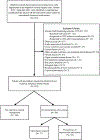Long-term patient-reported outcomes among patients undergoing revascularization vs medical therapy for intermittent claudication
- PMID: 38608965
- PMCID: PMC11260535
- DOI: 10.1016/j.jvs.2024.03.455
Long-term patient-reported outcomes among patients undergoing revascularization vs medical therapy for intermittent claudication
Abstract
Objective: Society for Vascular Surgery guidelines recommend revascularization for patients with intermittent claudication (IC) if it can improve patient function and quality of life. However, it is still unclear if patients with IC achieve a significant functional benefit from surgery compared with medical management alone. This study examines the relationship between IC treatment modality (operative vs nonoperative optimal medical management) and patient-reported outcomes for physical function (PROMIS-PF) and satisfaction in social roles and activities (PROMIS-SA).
Methods: We identified patients with IC who presented for index evaluation in a vascular surgery clinic at an academic medical center between 2016 and 2021. Patients were stratified based on whether they underwent a revascularization procedure during follow-up vs continued nonoperative management with medication and recommended exercise therapy. We used linear mixed-effect models to assess the relationship between treatment modality and PROMIS-PF, PROMIS-SA, and ankle-brachial index (ABI) over time, clustering among repeat patient observations. Models were adjusted for age, sex, diabetes, Charlson Comorbidity Index, Clinical Frailty Score, tobacco use, and index ABI.
Results: A total of 225 patients with IC were identified, of which 40% (n = 89) underwent revascularization procedures (42% bypass; 58% peripheral vascular intervention) and 60% (n = 136) continued nonoperative management. Patients were followed up to 6.9 years, with an average follow-up of 5.2 ± 1.6 years. Patients who underwent revascularization were more likely to be clinically frail (P = .03), have a lower index ABI (0.55 ± 0.24 vs 0.72 ± 0.28; P < .001), and lower baseline PROMIS-PF score (36.72 ± 8.2 vs 40.40 ± 6.73; P = .01). There were no differences in patient demographics or medications between treatment groups. Examining patient-reported outcome trends over time; there were no significant differences in PROMIS-PF between groups, trends over time, or group differences over time after adjusting for covariates (P = .07, P = .13, and P =.08, respectively). However, all patients with IC significantly increased their PROMIS-SA over time (adjusted P = .019), with patients managed nonoperatively more likely to have an improvement in PROMIS-SA over time than those who underwent revascularization (adjusted P = .045).
Conclusions: Patient-reported outcomes associated with functional status and satisfaction in activities are similar for patients with IC for up to 7 years, irrespective of whether they undergo treatment with revascularization or continue nonoperative management. These findings support conservative long-term management for patients with IC.
Keywords: Intermittent claudication; Patient-reported outcome (PRO); Patient-reported outcome measure (PROM); Peripheral artery disease (PAD); Revascularization.
Published by Elsevier Inc.
Conflict of interest statement
Disclosures None.
Figures







Similar articles
-
Exercise for intermittent claudication.Cochrane Database Syst Rev. 2017 Dec 26;12(12):CD000990. doi: 10.1002/14651858.CD000990.pub4. Cochrane Database Syst Rev. 2017. PMID: 29278423 Free PMC article.
-
Effects of additional exercise therapy after a successful vascular intervention for people with symptomatic peripheral arterial disease.Cochrane Database Syst Rev. 2024 May 2;5(5):CD014736. doi: 10.1002/14651858.CD014736.pub2. Cochrane Database Syst Rev. 2024. PMID: 38695785 Free PMC article.
-
Omega-3 fatty acids for intermittent claudication.Cochrane Database Syst Rev. 2024 Oct 29;10(10):CD003833. doi: 10.1002/14651858.CD003833.pub5. Cochrane Database Syst Rev. 2024. PMID: 39470212
-
A systematic review supporting the Society for Vascular Surgery guideline update on the management of intermittent claudication.J Vasc Surg. 2025 Aug;82(2):688-697. doi: 10.1016/j.jvs.2024.12.135. Epub 2025 Apr 30. J Vasc Surg. 2025. PMID: 40316186
-
Clinical improvement after arterial revascularization is associated with exercise oximetry results.Vasc Med. 2025 Apr;30(2):147-154. doi: 10.1177/1358863X251313964. Epub 2025 Feb 24. Vasc Med. 2025. PMID: 39992118
Cited by
-
Novel Interventions to Improve Adherence to Guideline-Directed Medical Therapy in Claudicants.J Clin Med. 2025 Jul 28;14(15):5309. doi: 10.3390/jcm14155309. J Clin Med. 2025. PMID: 40806931 Free PMC article. Review.
-
Establishing Minimal Clinically Important Difference for PROMIS Physical Function Improvement After Revascularization for Peripheral Artery Disease.Adv Patient Rep Outcomes. 2025 Mar;1(1):100188. doi: 10.1016/j.apro.2025.100188. Epub 2025 May 9. Adv Patient Rep Outcomes. 2025. PMID: 40765721 Free PMC article.
References
-
- Conte MS, Pomposelli FB, Clair DG, Geraghty PJ, McKinsey JF, Mills JL, et al. Society for Vascular Surgery practice guidelines for atherosclerotic occlusive disease of the lower extremities: management of asymptomatic disease and claudication. J Vasc Surg. Mar 2015;61(3 Suppl):2s–41s. doi: 10.1016/j.jvs.2014.12.009 - DOI - PubMed
Publication types
MeSH terms
Substances
Grants and funding
LinkOut - more resources
Full Text Sources
Medical

